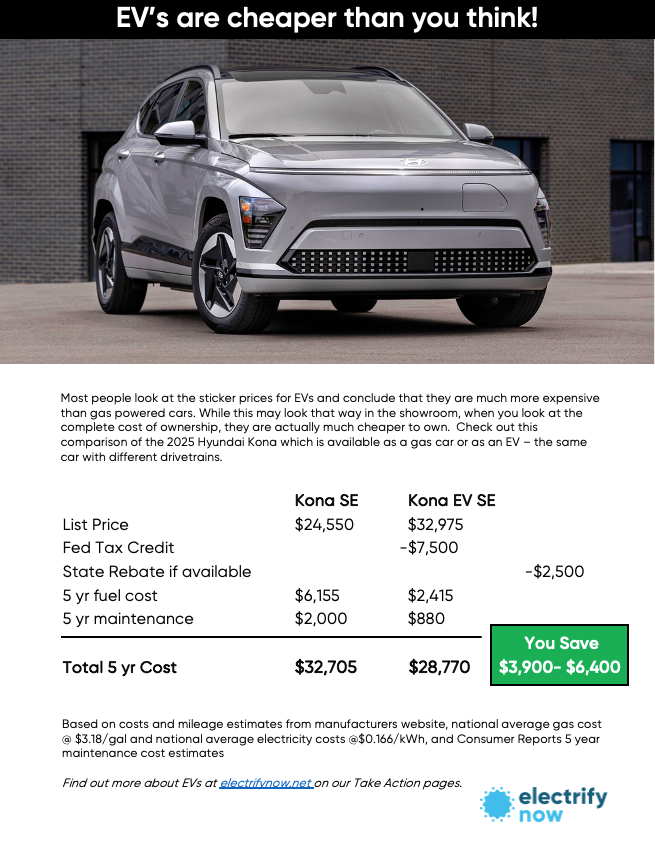3. Electrify your ride
Electric Vehicles are better - avoid 4-8 Tons of carbon emissions per year
Once you drive an EV you will see why EV owners love their cars. They perform better, they are much cheaper to operate, they don’t produce air pollution, and require very little maintenance. Instead of paying hundreds of dollars per month to the oil and gas giants, most of us can fuel up on clean energy right from our own homes. Used EVs are a great deal for short range commuting. Make your next car an EV and help create a clean energy future.
EV’s are cheaper than you think
Its true that the up-front costs for EV’s are still higher than gas power cars even though they have been coming down in price. But when you factor in the available incentives and the huge savings in operating costs, they will save you money over 5 years. Check out this comparison of two identical cars from Hyundai - one gas and one electric.
Find your EV and save money
EV Life has put together an amazing website that allows you to find the perfect EV and see its range and the charging infrastructure available for that car on long distance trips that you select. They also have a financing product that will save you hundreds of dollars per month by applying the available incentives up front to reduce your loan amount.
Find out what EVs qualify for Federal Tax Incentives
The IRA extended the federal tax credit for EVs, but introduced qualifying criteria in efforts to spur US manufacturing of EVs and EV batteries. Use this list of qualifying EVs from the IRS to find out if the car you are interested in will qualify for a tax credit. This fact sheet explains the new IRS rules for EV tax credits.
Our cars are the problem…
Another one quarter of US emissions
Burning dirty gasoline and diesel for transportation contributes 27% of our total greenhouse gas emissions in the U.S. Here in Oregon, transportation accounts for over 40% of our emissions and is a major contributor to smog and air quality issues.
Cars and Trucks
The vast majority of transportation emissions in the US and around the world come from cars and trucks and nearly 60% is from the cars that we drive every day. Taking public transportation, or riding a bike or an e-bike are great ways to reduce transportation emissions, but the only way to eliminate these emissions is to replace our cars and trucks with electric vehicles.
Air travel
While it is important to avoid unnecessary air travel, most people are surprised to find out that aircraft account for only 3% of our total emissions. That’s because most air travel is done by a relatively small portion of the population. If you are a frequent flyer, you have an outsize impact on the environment. Look for ways to reduce your air travel to lower your impact.
75 Tons of CO2
The typical gasoline or diesel powered car will produce 4-8 Tons of CO2 per year adding up to a total of over 75 Tons of CO2 over its 15 year lifespan. Every new car purchased virtually guarantees that 75 tons of additional carbon pollution will be released into the atmosphere.
EVs are the answer…
EVs are cleaner
Electric Vehicles produce 50 - 60% fewer total emissions than gasoline powered vehicles on average, even when taking into account the production of the batteries. On average, an EV will get the equivalent of 91 MPG charged on standard electricity. When charged with renewable energy, an EV will produce ZERO emissions.
What about dirty electricity?
This map from the Union of Concerned Scientists shows the MPG rating that a gas burning car would have to achieve to be equivalent to the emissions produced by a typical EV. These numbers vary by state because the cleanliness of the electricity grid varies by region. Even in states with the dirtiest grid, it would be hard to find a gas car that would be cleaner than an EV. And, these numbers go up every year as the grid gets cleaner.
EVs perform better
EVs are half the cost to operate, require much less maintenance, have higher reliability, last longer, and they are safer than gasoline powered vehicles. And their superior driving performance makes them more fun to drive!
EVs are affordable
Batteries are the most expensive components in an EV and prices have dropped sharply over the past few years. Today there are 28 EV models available in the US and 14 of them cost under $49,000 which is the national average new car sales price. Plus, state and federal incentives can take thousands of dollars off the sticker price making them even more affordable.
Save hundreds of $ each year
A typical car in the US is driven over 14,000 miles per year and the national average for gasoline expenses is over $2,000 per year. A typical EV will use $500 worth of electricity to go the same distance which will save you hundreds of dollars per year in operating expenses - plus you won’t have to stop at the gas station. And, maintenance is much cheaper since there are fewer systems and parts to repair and service.
What about the batteries?
It takes more energy to manufacture EV batteries, but the extra emissions from production are made up for in about one year of driving due to the substantially lower emissions from driving. Over its lifetime, the entire emissions from manufacturing to operation are about one half of a conventional car or less. And, as the grid gets cleaner, and more people sign up for renewable energy at home, EVs will get cleaner and cleaner.
Your house is a gas station
Nearly all new EVs have a range of at least 100 miles which is more than adequate for typical daily driving for most households. Some models can go as far as 300 miles on a single charge. Charging stations are proliferating rapidly and charging speeds are increasing. Next generation fast chargers will achieve fill up speeds similar to gas pumps. For daily driving, home charging with a regular household outlet is more than sufficient to keep an EV charged.
Shouldn’t I drive my car until it dies?
For most products it makes sense not to replace them too often. For products like cars that burn fossil fuels, the sooner you ditch them the better. A car will produce about the same carbon emissions in one year of driving than it took to make it. We need people like you to adopt new EVs to start cleaning up the fleet. Let someone else drive your old car and use your dollars to support the solution - an EV charged with renewable energy.
Lots of choices
Nearly every major car manufacturer has an EV that is available in the US and many more are launching EV models in the next year. There are options from small economy sized cars, to sedans to SUV’s and soon pickup trucks will be available. Used EVs are also an attractive option and are becoming more available.


















